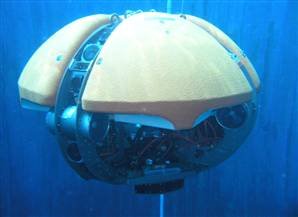Carnegie Mellon University(CMU) recently developed an underwater robot named Deep Phreatic Thermal Explorer (DEPTHX). This autonomous underwater vehicle is 2 meters in diameter and weighs about 1300 kilograms. DEPTHX is a four degree-of-freedom autonomous underwater vehicle,it can spin and move in any direction, and due to the fact that it has very high buoyancy and very low center of mass, it is ideal for underwater exploration as it is extremely stable when floating upright.

The software used for navigation and mapping is simultaneous localization and mapping, or SLAM, developed by Associate Research Professor David Wettergreen of CMU. SLAM allows the vehicle to build a map of its three-dimensional surroundings, and this helps to determine the vehicle' location easily in the bottom of Zacaion Cenote. Besides, the map also carries information on the water temperature and salinity levels.
In February 2007, DEPTHX successfully exlored a 115 meters deep sinkhole in eastern Mexico, and this May, the team is planning a expedition to Zacatone Cenote in central Mexico, which is over 300 meters deep. Previous explorations into Zacatone Cenote have not gone deeper than 50 meters. The goal of this exploration is to study the sinkhole's underwater environment and to discover what kinds of organisms are still living in the deepest sink hole in the world, at the same time also creating-dimensional map of the sink hole.

DEPTHX is designed for unexplored territory, where there is no external navigating. Using its autonomous navigation, robot can go to places where human could not possibly go due to its extreme environmental condition.
Exploring the deepest region where no one has gone before seems to be a big expedition, however, all these are actually preparation for seeking life on Europa, an ice-covered moon of Jupiter.
U036472X Teo Hong Wee
References:http://www.ri.cmu.edu/projects/project_544.html http://www.frc.ri.cmu.edu/projects/depthx/
5 comments:
Choo Liang Kwang U046028R
Interesting robot for deep sea exploration. We certainly need one for that kind of job, as it will be extremely dangerous and quite impossible (i think) to send a human down to that depth.
Our knowledge of this world is not yet complete. There are lots of things that have not been discovered or are unknown. Robots like these can aid us in finding them. Who knows, there might be a miracle down there that may be used to treat certain diseases...
U045926H Wong Jia Hui
CMU's SLAM proves to be a very useful technology, that can be applied in various fields. As in the following post I wrote on Groundhog, also developed by CMU, SLAM was also used.
These show the same mapping technology applied in two very different areas, from deep sea exploration to mapping abandoned mines.
I think this is exactly what engineers should try to achieve. To develop an excellent and state-of-the-art technology, and to apply it in as many useful ways as possible.
The use of SLAM in such different areas also show the demand and usefulness of autonomous map-building.
I think we'll definitely see more of SLAM technology incorporated in more robots to come.
Yu zhenyu U037786A
the robot is very useful for exploring in deep sea since humans could not take the pressure when they are in the deep sea.
in many areas, robots could reach where human may not reach so far (i am sure we could reach such a place in the future). hence currently robots are the only media we could use to reach those unknown world.
An interesting robot for deep sea exploration. It would also find applications in exploring ship wrecks. For instance the ocean offshore Alaska is littered with shipwrecks. More than 1,100 ships have wrecked off the coast of Alaska in the past 200 years. It might contain certain artifacts which might be priceless. Identifying such shipwrecks at such depth would be inhuman. I believe we might see a Titanic II in the near future :).
Vignesh Viswanathan (U045971E)
This robot explores places where humans themselves are currently incapable of exploring due to limitation in technology. Given the chance, humans will want to explore these regions themselves. :) Is there a similar land prototype which can explore the crevices or craters of volcanoes and other inaccessible geographical structures? You mentioned that it's meant as a testbed for exploration in Europa. Will there be any challenges if it is used in outer space? Thanks.
Rgds,
Ng Chin Ling (U047690E)
Post a Comment